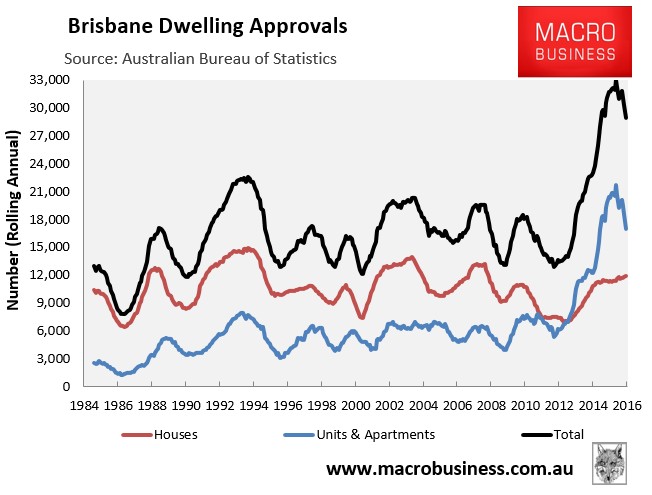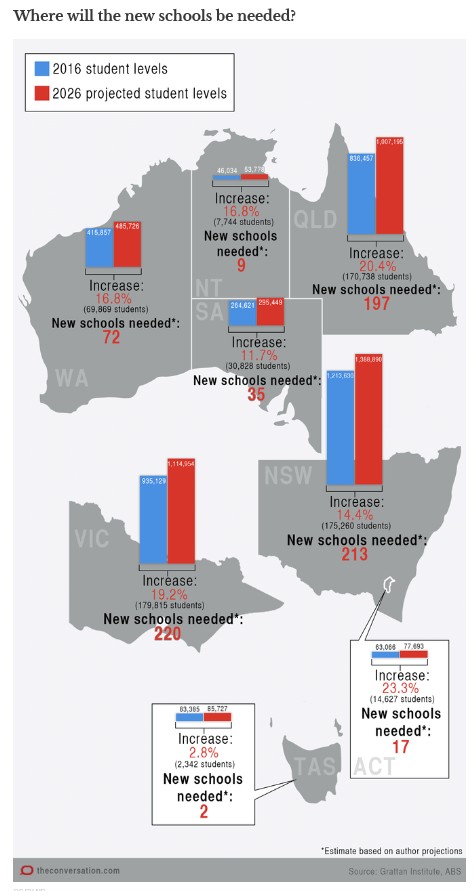The lack of planning and foresight to cope with the never-ending population (immigration) influx into Australia’s big cities never ceases to amaze.
The latest example of negligence comes from Brisbane, where the unprecedented boom in high-rise apartments (see next chart) has driven a shortage of inner-city school places.

From The SMH:
Queensland governments sold land set for “education” to developers until 2013 to build thousands of apartments in West End and South Brisbane without considering the impact on local schools in 2017.
Now “pissed off parents” and one school’s Parents and Citizens Association worry where their children will play as the schools – which cannot physically expand – cope with hundreds of extra students.
The 2014 study by the West End State School’s school council – never before made public – shows the region needs 700 new primary school places.
“The families enrolling at WESS are from an increasingly diverse national background, with increasing representation from countries in Asia and the Middle East where it is very normal for families to reside in compact apartments in high-density areas,” the WESS August 2014 School Council report reads…
West End Community Association president Dr Erin Evans said the emerging situation was a planning failure.
“It’s a canary in a coal mine for just how poor the planning has been in the area,” Dr Evans said…
Dozens of apartment complexes in West End and South Brisbane are now housing families that are sending their children to crowded local schools.
Sadly, this situation is playing-out across Australia’s big cities, with inner-city schools in Sydney and Melbourne also becoming crush-loaded by the population influx and unprecedented high-rise apartment construction.
Back in February 2016, Peter Goss, School Education Program Director at the Grattan Institute, penned an excellent article in The Conversation assessing the upcoming shortage of schools across Australia’s capital cities as the nation’s population balloons. This article estimated that the number of school students would balloon by 650,000 (17%) by 2026, which would require the building of an additional 400 to 750 new schools (up from 9,400 currently). NSW (mostly Sydney) would need an additional 220 schools to cope with an additional 19% of students over the next decade, whereas Victoria (mostly Melbourne) would require an additional 220 schools to cope with an additional 19% of students (see below graphic).

Inner city areas would be worst affected by the schools shortage, according to Grattan:
In the inner city, the big issue is the cost and scarcity of land… Governments have been much worse at planning for the booming number of inner-city children…
Worse is to come, especially in Melbourne. Melbourne’s five most central local government areas will each see a 30% to 60% increase in student numbers over the next decade… Inner-city parents in urban redevelopment zones are the most likely to have problems getting their children into a government school.
All of this, yet again, highlights Australia’s dysfunctional population ponzi in action.
The Federal Government massively ramped-up immigration from 2003 which, when combined with the mini baby boom encouraged by the baby bonus, is leading to surging demand for schooling.
However, the states have been unable to accommodate this growth – due in part to incompetence, but also through lack of funds courtesy of Australia’s famous vertical fiscal imbalance, whereby the federal government collects most of the revenue.
This dysfunction is arguably most apparent across inner city areas. The states have been successful in forcing urban consolidation and infill development, as evidenced by the proliferation of apartment development across our major cities. However, they have been totally unsuccessful in providing the necessary infrastructure to accommodate this growth, be it schools, hospitals or transport infrastructure.
To make matters even worse, the Turnbull Government recently relaxed visa rules to allow 6 year-old foreign students and their guardians visa entry into Australia’s primary schools, thus adding to the demand pressures.
It’s an epic planning fail across Australia’s various tiers of government.

